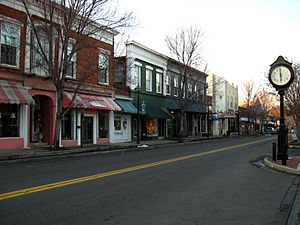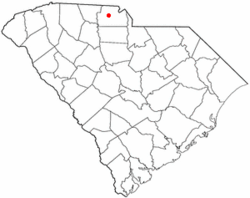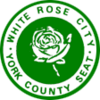York, South Carolina facts for kids
Quick facts for kids
York, South Carolina
|
|||
|---|---|---|---|

Downtown York, 2009
|
|||
|
|||
| Nickname(s):
The White Rose City
|
|||

Location of York, South Carolina
|
|||
| Country | United States | ||
| State | South Carolina | ||
| County | York | ||
| Government | |||
| • Type | Council-Manager | ||
| Area | |||
| • Total | 8.60 sq mi (22.27 km2) | ||
| • Land | 8.48 sq mi (21.96 km2) | ||
| • Water | 0.12 sq mi (0.31 km2) | ||
| Elevation | 761 ft (232 m) | ||
| Population
(2020)
|
|||
| • Total | 8,503 | ||
| • Density | 1,002.71/sq mi (387.15/km2) | ||
| • Demonym | Yorkite | ||
| Time zone | UTC-5 (Eastern (EST)) | ||
| • Summer (DST) | UTC-4 (EDT) | ||
| ZIP code |
29745
|
||
| Area code(s) | 803, 839 | ||
| FIPS code | 45-79630 | ||
| GNIS feature ID | 1251530 | ||
York is a city in York County, South Carolina, United States. It is the main city and the county seat of York County. In 2020, about 8,503 people lived there. York is located about 27 miles (43 km) southwest of Charlotte, North Carolina. It is also 13 miles (21 km) west of Rock Hill, South Carolina.
Contents
History of York, South Carolina
Early Settlers and Native Americans
The first European settlers arrived in the York area in the early 1750s. They traveled south from Pennsylvania and Virginia. These settlers brought county names like Lancashire and Yorkshire from England to Pennsylvania, and then to South Carolina.
Before these settlers, the Catawba Indians were the first known people living in York County.
How York Became a Town
The town of York was first called Fergus's Crossroads. This name came from a tavern owned by two brothers, William and John Fergus. The tavern was at a busy intersection of old roads.
In 1785, York County was created. State law said each new county needed a courthouse and public buildings. Fergus's Crossroads was chosen because it was near the center of the new county. This made it the perfect spot for the new county seat.
Yorkville: The County Seat
The town was officially named Yorkville in 1785. It was located between two important Revolutionary War battle sites: the Battle of Kings Mountain and the Battle of Williamson's Plantation. York was the only county in South Carolina that was not defeated during that war.
By 1823, Yorkville had 451 people. There were 80 houses, eight stores, and five taverns. The town also had schools and a printing office. Many different types of workers lived there, including mechanics, lawyers, and doctors.
Yorkville became an official town on December 7, 1841. W.I. Clawson was the first mayor. The population grew to about 800 people. By 1860, Yorkville was the first town in the Upcountry region to have gas lighting.
In 1853, a local newspaper called the Yorkville Enquirer was started. It was published every week until 2006. Then it joined with another newspaper to become the Enquirer-Herald.
In 1915, the people of the town voted to make the name shorter. They changed it from "Yorkville" to "York".
Education in Early York
Before the American Civil War, private schools were common in Yorkville. In 1854, the Yorkville Female Academy opened. The next year, two young graduates from Citadel opened the King's Mountain Military Academy. This school closed during the Civil War. After the war, one of the founders reopened it. Today, this site is a treatment center for children called York Place.
Historic Buildings and Landmarks
York has many old and important buildings. Several are listed on the National Register of Historic Places. This means they are special places that are protected.
- Allison Plantation
- Hart House
- Wilson House
- Witherspoon-Hunter House
- York County Courthouse
- York Historic District
The Rose Hotel was built in 1852. It was known as one of the fanciest hotels in the area. Today, it has been fixed up and turned into apartments.
The First Presbyterian Church was designed in 1846. It was finished after the Civil War. This church building is also on the National Register of Historic Places.
The current York County Courthouse was finished in 1914. It is the fourth courthouse to be built on that spot. The third courthouse was designed by Robert Mills. He also designed the Washington Monument. Most court activities now happen at the Moss Justice Center, on the edge of town.
In 1976, downtown York was named a Historic District. This was part of the Bicentennial celebration. It is one of the biggest historic districts in South Carolina. It has over 180 historic buildings and landmarks.
Geography of York
York is located at 34.994673 degrees North latitude and -81.239420 degrees West longitude. The city covers a total area of about 7.9 square miles (20.5 square kilometers). Most of this area is land, with a small part being water.
Population of York
The population of York has grown over many years.
| Historical population | |||
|---|---|---|---|
| Census | Pop. | %± | |
| 1850 | 511 | — | |
| 1860 | 1,360 | 166.1% | |
| 1880 | 1,330 | — | |
| 1890 | 1,553 | 16.8% | |
| 1900 | 2,012 | 29.6% | |
| 1910 | 2,326 | 15.6% | |
| 1920 | 2,731 | 17.4% | |
| 1930 | 2,827 | 3.5% | |
| 1940 | 3,495 | 23.6% | |
| 1950 | 4,181 | 19.6% | |
| 1960 | 4,758 | 13.8% | |
| 1970 | 5,081 | 6.8% | |
| 1980 | 6,412 | 26.2% | |
| 1990 | 6,709 | 4.6% | |
| 2000 | 6,985 | 4.1% | |
| 2010 | 7,736 | 10.8% | |
| 2020 | 8,503 | 9.9% | |
| U.S. Decennial Census | |||
York first appeared in the 1850 U.S. Census as "Yorkville." At that time, it had a population of 511 people.
York's Population in 2020
The 2020 United States census counted 8,503 people living in York. There were 3,376 households and 2,177 families in the city.
| Race | Num. | Perc. |
|---|---|---|
| White (non-Hispanic) | 4,282 | 50.36% |
| Black or African American (non-Hispanic) | 3,025 | 35.58% |
| Native American | 26 | 0.31% |
| Asian | 73 | 0.86% |
| Pacific Islander | 5 | 0.06% |
| Other/Mixed | 369 | 4.34% |
| Hispanic or Latino | 723 | 8.5% |
Education in York
York is part of York School District One. This district has seven elementary schools, one intermediate school, and one middle school. It also has one high school, which is York Comprehensive High School.
The city of York has a public library. It is a branch of the York County Library system.
- Lake Pointe Academy (opened in 2005)
Famous People from York
- Dulcina DeBerry (1878-1969) - She was a librarian and an educator.
See also
In Spanish: York (Carolina del Sur) para niños



